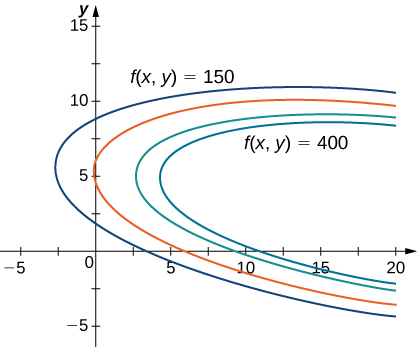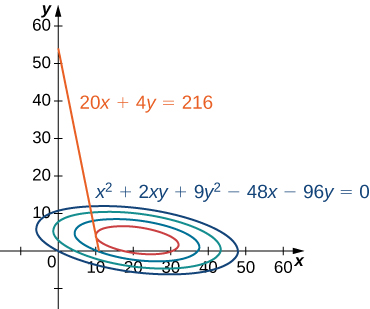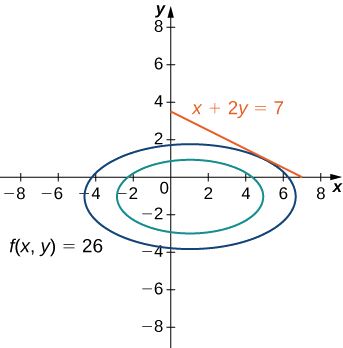14.8: Lagrange Multipliers
( \newcommand{\kernel}{\mathrm{null}\,}\)
- Use the method of Lagrange multipliers to solve optimization problems with one constraint.
- Use the method of Lagrange multipliers to solve optimization problems with two constraints.
Solving optimization problems for functions of two or more variables can be similar to solving such problems in single-variable calculus. However, techniques for dealing with multiple variables allow us to solve more varied optimization problems for which we need to deal with additional conditions or constraints. In this section, we examine one of the more common and useful methods for solving optimization problems with constraints.
Lagrange Multipliers
In the previous section, an applied situation was explored involving maximizing a profit function, subject to certain constraints. In that example, the constraints involved a maximum number of golf balls that could be produced and sold in
is an example of an optimization problem, and the function

In Figure

As mentioned previously, the maximum profit occurs when the level curve is as far to the right as possible. However, the level of production corresponding to this maximum profit must also satisfy the budgetary constraint, so the point at which this profit occurs must also lie on (or to the left of) the red line in Figure
Let
Assume that a constrained extremum occurs at the point
where
where the derivatives are all evaluated at
which implies that the gradient is either the zero vector
To apply Theorem
- Determine the objective function
- Set up a system of equations using the following template:
- Solve for
- The largest of the values of
Use the method of Lagrange multipliers to find the minimum value of
Solution
Let’s follow the problem-solving strategy:
1. The objective function is

2. We then must calculate the gradients of both
The equation
which can be rewritten as
Next, we set the coefficients of
The equation
3. This is a linear system of three equations in three variables. We start by solving the second equation for
Since
4. Next, we evaluate
We get
So it appears that
Use the method of Lagrange multipliers to find the maximum value of
subject to the constraint
- Hint
-
Use the problem-solving strategy for the method of Lagrange multipliers.
- Answer
-
Subject to the given constraint,
Let’s now return to the problem posed at the beginning of the section.
The golf ball manufacturer, Pro-T, has developed a profit model that depends on the number
where
Solution:
Again, we follow the problem-solving strategy:
- The objective function is
- So, we calculate the gradients of both
- We use the left-hand side of the second equation to replace
- We then substitute
A company has determined that its production level is given by the Cobb-Douglas function
- Hint
-
Use the problem-solving strategy for the method of Lagrange multipliers.
- Answer
-
Subject to the given constraint, a maximum production level of
In the case of an objective function with three variables and a single constraint function, it is possible to use the method of Lagrange multipliers to solve an optimization problem as well. An example of an objective function with three variables could be the Cobb-Douglas function in Exercise
Maximize the function
Solution
1. The objective function is
2. Next, we calculate
3. Since each of the first three equations has
4. Then, we evaluate
Use the method of Lagrange multipliers to find the minimum value of the function
subject to the constraint
- Hint
-
Use the problem-solving strategy for the method of Lagrange multipliers with an objective function of three variables.
- Answer
-
Evaluating
Problems with Two Constraints
The method of Lagrange multipliers can be applied to problems with more than one constraint. In this case the objective function,
and it is subject to two constraints:
There are two Lagrange multipliers,
Find the maximum and minimum values of the function
subject to the constraints
Solution
Let’s follow the problem-solving strategy:
- The objective function is
- We then calculate the gradients of
- The first three equations contain the variable
- We substitute
Use the method of Lagrange multipliers to find the minimum value of the function
subject to the constraints
- Hint
-
Use the problem-solving strategy for the method of Lagrange multipliers with two constraints.
- Answer
-
Key Concepts
- An objective function combined with one or more constraints is an example of an optimization problem.
- To solve optimization problems, we apply the method of Lagrange multipliers using a four-step problem-solving strategy.
Key Equations
- Method of Lagrange multipliers, one constraint
- Method of Lagrange multipliers, two constraints
Glossary
- constraint
- an inequality or equation involving one or more variables that is used in an optimization problem; the constraint enforces a limit on the possible solutions for the problem
- Lagrange multiplier
- the constant (or constants) used in the method of Lagrange multipliers; in the case of one constant, it is represented by the variable
- method of Lagrange multipliers
- a method of solving an optimization problem subject to one or more constraints
- objective function
- the function that is to be maximized or minimized in an optimization problem
- optimization problem
- calculation of a maximum or minimum value of a function of several variables, often using Lagrange multipliers


